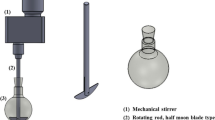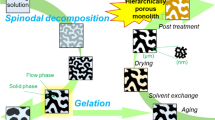Abstract
We report the chromatographic properties of a new type of epoxy polymer-based monolithic capillary column, the Tetrad-C column. The column was prepared by a completely new method—reaction of a tetra-functional epoxy monomer, 1,3-bis(N,N-diglycidylaminomethyl)cyclohexane (trade name Tetrad-C), with a diamine, 4-[(4-aminocyclohexyl)methyl)cyclohexane (BACM). This polymer monolith has no aromatic functional groups reducing chromatographic performance. The columns were carefully observed by scanning electron microscopy and evaluated chromatographically by use of a μ-HPLC system. It was found that morphological control of the epoxy polymer-based monolith was possible simply by changing the polymerization conditions, i.e., the polymerization temperature and/or the relative amounts of porogenic solvent and BACM. Another advantage was that volumetric shrinkage of the tetra-functional epoxy-based monolith during the polymerization reaction was much less than for the tri-functional epoxy-based monolithic (TEPIC) column reported in our previous paper. A Tetrad-C column 200 mm long afforded up to 10,000 plates for alkylbenzenes in reversed-phase-mode. This column can also work in HILIC mode, although the hydrophobicity of the column was greater than that of the TEPIC column. Heat treatment (160 °C for 2 h; to eliminate residual, unreacted, functional groups) had a negligible effect on column performance, indicating the columns were thermally stable.








Similar content being viewed by others
References
Olsen BA, Castle BC, Myers DP (2006) Trends Analyt Chem 25:796–805. doi:10.1016/j.trac.2006.06.005
Sadilek P, Satinsky D, Solich P (2007) Trends Analyt Chem 26:375–384. doi:10.1016/j.trac.2007.02.002
Hewitt LM, Marvin CH (2005) Mutat Res 589:208–232. doi:10.1016/j.mrrev.2005.02.001
Claessens HA, Straten MA (2004) J Chromatogr A 1060:23–41. doi:10.1016/j.chroma.2004.08.098
Unger KK, Jilge G, Kinkel JN, Hearn MTW (1986) J Chromatogr 359:61–72. doi:10.1016/0021-9673(86)80062-0
Moriyama H, Anegayama M, Komiya K, Kato Y (1995) J Chromatogr A 691:81–89. doi:10.1016/0021-9673(94)00744-T
Knox JH (1977) J Chromatogr Sci 15:352–364. ISSN 0021-9665
Nakanishi K (1997) J Porous Mater 4:67–112. doi:10.1023/A:1009627216939
Minakuchi H, Nakanishi K, Soga N, Ishizuka N, Tanaka N (1997) J Chromatogr A 762:135–146. doi:10.1016/S0021-9673(96)00944-2
Minakuchi H, Nakanishi K, Soga N, Ishizuka N, Tanaka N (1998) J Chromatogr A 797:121–131. doi:10.1016/S0021-9673(97)00947-3
Svec F, Frechet JMJ (1996) Anal Chem 68:315–321. doi:10.1021/ac950726r
Svec F, Frechet JMJ (1996) Science 273:205–211. doi:10.1126/science.273.5272.205
Svec F, Frechet JMJ (1992) Anal Chem 64:820–822. doi:10.1021/ac00031a022
Viklund C, Ponten E, Glad B, Irgum K, Horsted P, Svec F (1997) Chem Mater 9:463–471. doi:10.1021/cm9603011
Yu C, Dacey MH, Svec F, Frechet JMJ (2001) Anal Chem 73:5088–5096. doi:10.1021/ac0106288
Yu C, Xu MC, Svec F, Frechet JMJ (2002) J Polym Sci Polym Chem 40:755–769. doi:10.1002/pola.10155
Rohr T, Hilder EF, Donvan JJ, Svec F, Frechet JMJ (2003) Macromolecules 36:1677–1684. doi:10.1021/ma021351w
Peters EC, Svec F, Frechet JMJ, Viklund C, Irgum K (1999) Macromolecules 32:6377–6379. doi:10.1021/ma990538t
Tsujioka N, Hira N, Aoki S, Tanaka N, Hosoya K (2005) Macromolecules 38:9901–9903. doi:10.1021/ma051409h
Hosoya K, Hira N, Yamamoto K, Nishimura M, Tanaka N (2006) Anal Chem 78:5729–5735. doi:10.1021/ac0605391
Hosoya K, Sakamoto M, Akai K, Mori T, Kubo T, Kaya K, Okada K, Tsujilka N, Tanaka N (2008) Anal Sci 24:149–154. doi:10.2116/analsci.24.149
Author information
Authors and Affiliations
Corresponding author
Rights and permissions
About this article
Cite this article
Hosoya, K., Mori, T., Sakamoto, M. et al. Properties of a Non-Aromatic Epoxy Polymer-Based Monolithic Capillary Column for μ-HPLC. Chroma 70, 699–704 (2009). https://doi.org/10.1365/s10337-009-1260-3
Received:
Revised:
Accepted:
Published:
Issue Date:
DOI: https://doi.org/10.1365/s10337-009-1260-3




